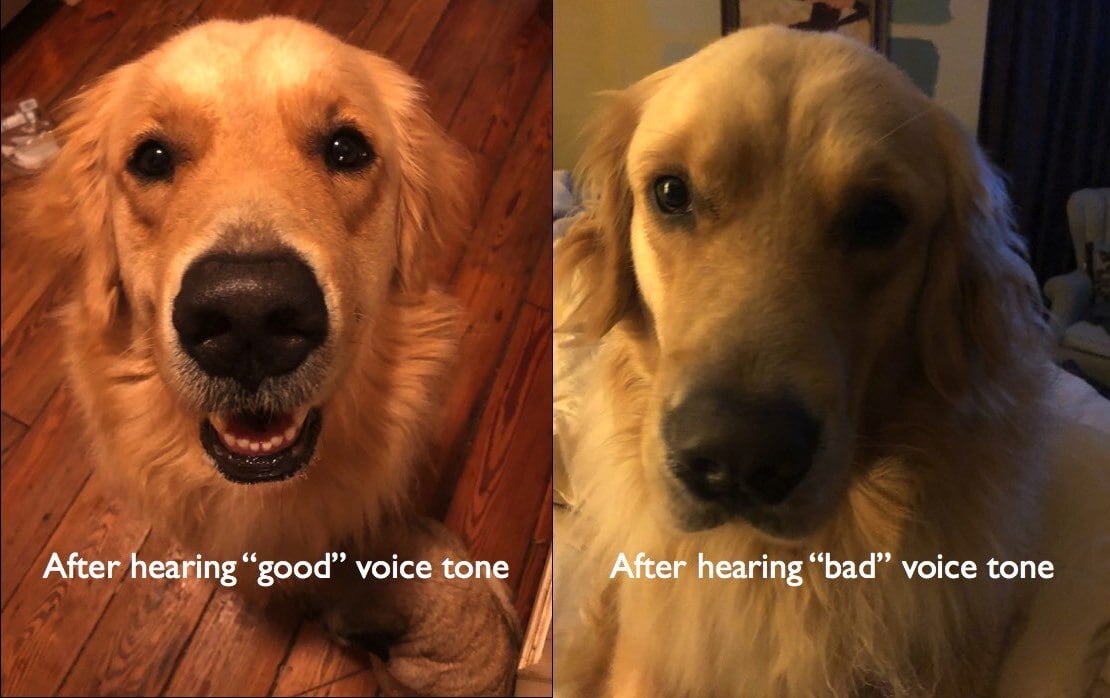It's all about tone of voice
Dogs don't have extensive vocabularies, but they do understand as many as 50 words. Mostly, dogs understand words that mean things that are important to a dog. What dogs lack in vocabulary, they make up for with their attention to voice inflection and tone. Dogs are always listening to us. They've learned that tone and inflection are just as important as the actual words we say. The human voice is a broad palette, with much more available to us than just the choice of words we use. Likewise, voice acting is about more than just a pretty voice - it's about communicating via inflection, pace, tone and rhythm. Great voice artists are able to take mundane words on a script, and bring meaning, emotion and importance to those words.

Measuring the importance of inflection
My assessment that dogs respond more to the inflection I use than the actual words I choose, is based on many years of experience. It's just something I noticed. So, I tried an experiment. I gave commands to my dogs without using consonants. I tried saying: "Do you want a treat?" without using consonants, only the vowel sounds. The words were not very recognizable, but I kept the same sing-song tone, ending with a questioning inflection. The excitement this generated in them was clear. They might not have known exactly what was in store for them, but they sure seemed to expect something. And I had their full attention.
Next, I tried saying "Do you want a treat" clearly and properly, but without any inflection at all, like a robot. The doggos reaction was only to look at me, and with much the same lack of enthusiasm as I delivered the words with. I sounded bored and detached, so why should they get excited, right? Maybe they just didn't understand the words delivered in such a way. Or, maybe, they did understand the words - but didn't believe me.
Finally, I tried just humming the phrase "Do you want a treat?", not really sounding the words at all, but keeping the exact same inflection as if I was saying the words. Amazingly, even though the two puppers didn't know exactly what I was saying, they seemed to understand from my tone and inflection, that whatever it was, it meant something good for them! Possibly even... a treat?
I discovered that yes, tone and inflection are everything when it comes to the human voice.
I decided to break down what exactly worked - and didn't work - with regards to inflection when saying things that are both familiar and important to my doggos. In this semi-scientific and largely lazy experiment, I feel that I discovered that my dogs always know if I'm using the "wrong" tone, and generally disregard what I'm attempting to communicate in such cases.
In the world of commercial voiceover, I'm sure the same is true: just reading words of a script - without true intent and meaning - will not get the audience response intended in the message. Because we humans are just like dogs - we only care when the voiceover makes us believe there's something good for us in the message! And we do it by subconsciously assessing meaning and intent via tone and inflection.

Do cats care about the tone of your voice?
Cats absolutely respond (at least my cat) to the tone of voice used to address them. In fact, their ears are the big tell. In this image, I tried my scariest "rock radio imagine" voice. Even if you don't own a single cat, I'm sure you can tell exactly what Simon the orange tabby is feeling here: he was totally unimpressed by the idea of an hour of non-stop, commercial-free rock.
Keeping it real with voiceover
Any of us (dogs and cats included) seem to know instantly when a person's voice inflection is not sincere. Bad acting is just-- bad. Bad because voice acting is supposed to be believable. When a voice actor reads a line from a script, it's supposed to sound not like it's being read, but like it's being said. Yeah, there is totally a difference. This matters for anyone who is in the business of communicating with voice, whether in person or via recording. Because if the audience does not believe what you are communicating, the message - and the opportunity - is lost. The days of the "radio announcer" are dead and gone, mostly due to the fact that old school "announcing" is not at all about inflection, meaning and tone. It was more an exercise in male vanity, to be truthful. And while many older folks might respond to the old school, deep-voiced announcer of the 70s, most contemporary audiences only find such voice delivery antiquated - or at best - humorous, like a pair of pleated pants.
And yes- I have experimented with a "radio voice of God" on my dogs as well as the cat. The pug? Well, he cowers. Because as anyone knows, a deep and hard male voice means something sinister is about to happen. The 110 pound Golden Retriever? In most every case I've said anything in my scary radio imaging voice, he becomes angry, making hard eye contact, followed by growly barking. I'm not a dog psychologist, but I am pretty sure the Golden doesn't like that tone of voice at. all. (and probably has lost a lot of respect for me for talking that way)
From my experience as both a voice actor and producer of voiceover, I'm also reasonably sure most people don't respond well to sinister, deep voice delivery - unless it's appropriate - as in the case of scary movie trailers, pro sporting events, hard-hitting news promos, etc.
Radio Imaging: where the "Voice of God" still reins supreme
You don't have to spend long listening to contemporary radio to catch a gravel-voiced, pre-recorded announcer saying some worn out crap like "More music, less talk. The Rock Station!". So, it might seem puzzling in these times that radio programmers still favor those type of old voices to represent their radio station's branding.
There is a reason, though, that your local radio station's branding (also known as radio imaging within the industry) favors what should be a dead genre of voice style. Simply put, the radio industry struggles to figure out how to makes its own branding stand apart from the myriad voices of its own sponsors.
A typical radio station imaging ID will play in the midst of a commercial break - which is literally filled with back-to-back voiceover. Listen carefully to such commercial breaks, and you'll notice a wide variety of voices- from local clients doing their own ads, to many of the nation's top men and women voice artists. So, the problem is: How to make the radio station's imaging voice stand apart in a sea of voices.
Radio has become the exception to "don't read the script, say the script". Radio station imaging voices are still overwhelmingly "old school" (limited tone and inflection) as well as being almost entirely male. This kinda works, in the sense that it helps any radio station stand out with its own branding in the midst of commercial breaks. It also, however, works against any given radio station's attempt at standing out against its competitor radio stations. That's because, of course, the old-school radio announcer imaging voice is what almost all radio station's sound like. If you've heard one rock station in Topeka, you've heard 'em all - from coast to coast.
But there are other ways for voiceover to stand out
Voice acting skill aside, how else can a voice sound different and stand out in a sea of voices? As a producer of voiceover, I am keen on technical, often somewhat subtle "effects" being applied to a voiceover in commercials or radio station imaging. Adding a dose of dynamic compression to magnify the breathyness, a subtle amount of echo, or even a smidge of distortion, can make a voice pop. It's beyond the scope of what I'm covering here to dive deep into the technical realm, but assuming you're starting with a good, honest and believable voice artist, the right amount of sweetening in post-production can do wonders to help any voice - and the brand it represents - stand out.
Unusual voices - people with unique tone, be it raspy or sultry, high or giddy - also helps tremendously. Sometimes, having the voice actor whisper close to the mic can create a startling presence that propels a message from blah to woah! And even the opposite: having the voice actor stand back from the mic and deliver the message just short of yelling, can bring urgency and juicy enthusiasm.
The most important factor of all in voiceover as it relates to branding is: consistency. Once the voice, style and technical treatment are arrived at, it's important to do that every single time a voiceover is recorded for that brand: Same voice actor, same delivery, same technical sweetening. Because audio branding is just like any visual brand: once you get it right, you keep it.
Keep the sound of your brand as consistent as your visual branding, and your audience will keep recognizing your brand.

About Ray Norman
Ray Norman is a voice actor and sound designer, with decades of experience in broadcast, advertising and music production. You can hear examples of his work here.